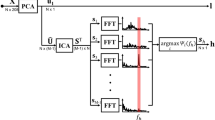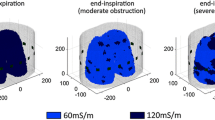Abstract
A two-dimensional model of the thorax has been analysed to study the electrical potential distributions under various physiological conditions in relation to electrical field plethysmography. The quasi-harmonic equation has been solved over a cross-section of the thorax with the help of a finite-element method under the assumptions of homogeneous and isotropic tissue characteristics. Potentials along the boundary of the model have been plotted and the optimum electrode locations derived from the analysis corresponded well with the experimentally obtained positions. It is concluded that cardiac activity can be monitored effectively in the presence of lung activity. It has also been found that, with a suitable modification of the positions of the pick-up electrodes, lung activity can also be monitored. The equipotential lines drawn and the current densities computed have provided a picture of the field distribution pattern in the thoracic model. The analysis showed that the technique fulfils the preliminary requirements of a plethysmographic tool.
Similar content being viewed by others
References
Benjamin, J. M. Jr.,Schwan, H. P. Kay, C. F. andHafkenscheil, J. H. (1950) The electrical conductivity of living tissues as it pertains to electrocardiography.Circ.,2, 321–335.
Bhattacharya, B. (1982) Analytical and clinical studies on electrical field plethysmography as a new non-invasive tool for monitoring mechanical activities of the heart. Ph.D. thesis, Indian Institute of Technology, New Delhi, 31–34.
Collins, R. J. (1973) Bandwidth reduction by automatic renum-bering,Int. J. Num. Meth. Eng.,6, 345–356.
Friedewalt, V. E. Jr. (1977)Textbook of echocardiography. W. B. Saunders, 296–300.
Garrison, J. B., Weiss, J. L., Maughan, W. L., Tuck, O.M. Guier, W. H. andFortuin, N. J. (1977) Quantifying regional wall motion and thickening in two-dimensional echocardiography with a computer aided contouring system. InComputers in cardiology. IEEE Computer Society, 25–35.
Geddes, L. A. andBaker, L. E. (1967) The specific resistance of biological material—a compendium of data for the biomedical engineer and physiologist.Med. & Biol. Eng.,5, 271–293.
Gray, W. H. andAkin, J. E. (1978) An improved method for contouring on isoparametric surfaces. Report prepared by the Oak Ridge National Laboratory, Tennesse, Contract W-7405-eng-26.
Guha, S. K., Tandon, S. N. andJain, V. K. (1973a) Two dimensional analysis of electric field in the human body.J. Inst. Engrs. (India),54, 4–7.
Guha, S. K., Khan, M. R. andTandon, S. N. (1973b) Electrical field distribution in the human body.Phys. Med. Biol.,18, 712–720.
Guha, S. K., Tandon, S. N. andKhan, M. R. (1974) Electrical field plethysmography.Biomed. Eng.,9, 510–514.
Ledley, R. S., Huang, H. K. andMazziotta, J. C. (1977)Cross sectional & anatomy—an atlas for computerized tomography. Williams & Wilkins.
Mohapatra, S. N. andHill, D. W. (1975) The changes in blood resistivity with haematocrit and temperature.Europ. J. Int. Care Med.,1, 153–162.
Natarajan, R. andSeshadri, V. (1976) Electric-field distribution in the human body using finite-element method.Med. & Biol. Eng.,14, 489–493.
Pasquali, E. (1967) Problems in impedance plethysmography: electrical characteristics of skin and lung tissue.-——Ibid.,5, 249–258.
Patterson, R. P. (1985) Sources of the thoracic cardiogenic electrical impedance signal as determined by a model.Med. & Biol. Eng. & Comput.,23, 411–417.
Peura, R. A., Penney, B. C., Arcui, J., Anderson, F. A. Jr. andWheeler, H. B. (1978) Influences of erythrocyte velocity on impedance plethysmographic measurements.-——Ibid.,16, 147–154.
Plonsey, R. (1969) Volume conductor fields. InBioelectric phenomena. McGraw-Hill, 202–275.
Rush, S., Abildskov, J. A. andMcFee, R. (1963) Resistivity of body tissues at low frequencies.Circ. Res.,12, 40–50.
Schwan, H. P. andKay, C. F. (1957) The conductivity of living tissues.Ann. NY Acad. Sci.,65, 1007–1013.
Schwan, H. P. (1963) Determination of biological impedances. InNastuk, W. L. (Ed.),Physical techniques in biological research, vol. VI. Academic Press.
Witsoe, D. A. andKinnen, E. (1967) Resistivity of lung at 100 kHz.Med. & Biol. Eng.,5, 239–248.
Author information
Authors and Affiliations
Rights and permissions
About this article
Cite this article
Bhattacharya, B., Tandon, S.N. Potential distribution in the thorax in relation to electrical field plethysmography. Med. Biol. Eng. Comput. 26, 303–309 (1988). https://doi.org/10.1007/BF02447085
Received:
Accepted:
Issue Date:
DOI: https://doi.org/10.1007/BF02447085




